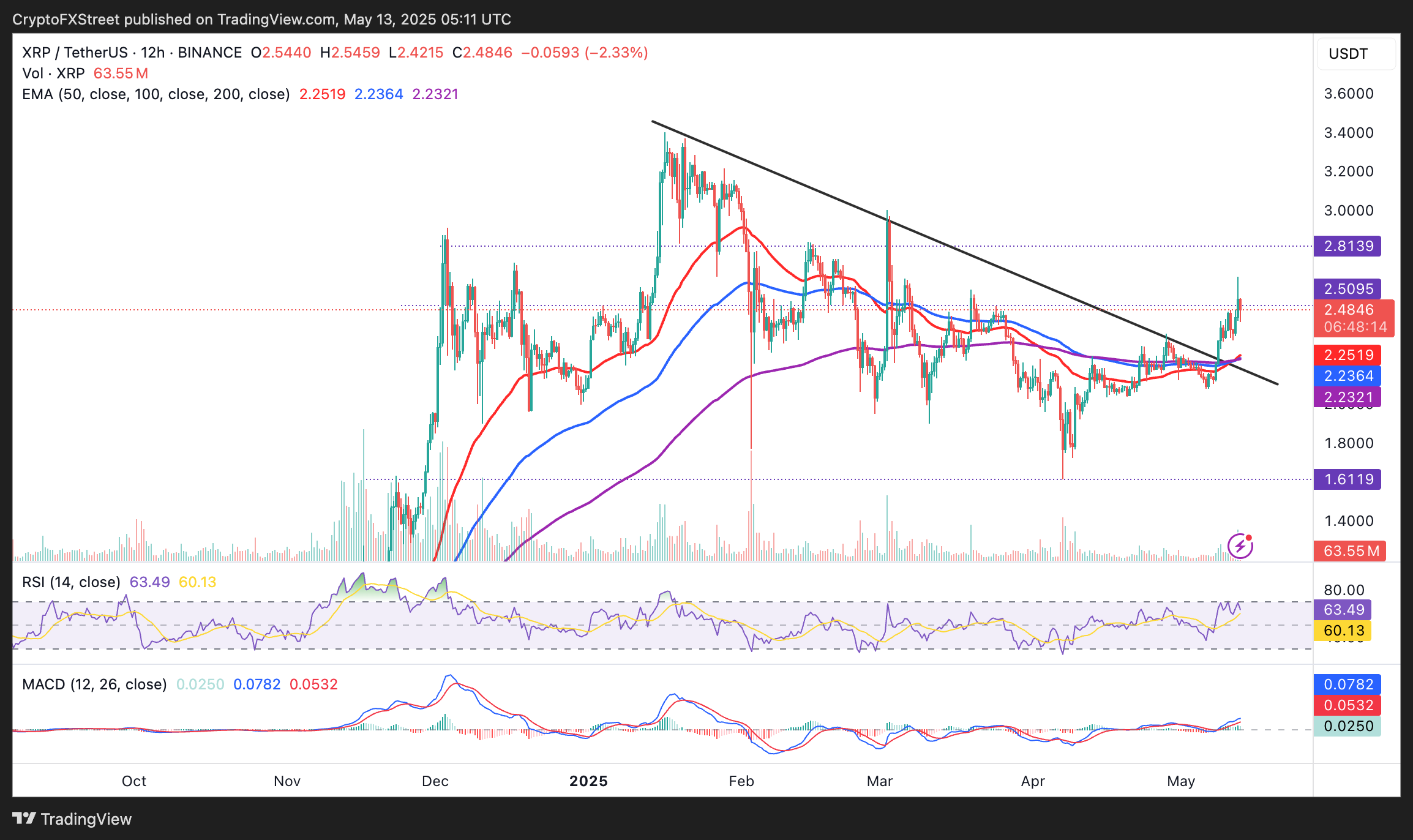Ripple Price Prediction: XRP rally stalls as SEC Chair Paul Atkins vows to end ad hoc enforcement
- XRP hits $2.65, but pares gains amid a crypto rally fuelled by a US-China trade deal.
- Under Paul Atkins's leadership, the SEC will develop a rational regulatory framework for crypto asset markets.
- Atkins said during the Crypto Task Force roundtable that policymaking will not depend on ad hoc enforcement actions.
- XRP drops to test $2.40 support as RSI nears midline, signaling increased bearish momentum.
Ripple (XRP) price trims gains to exchange hands at $2.44 at the time of writing on Tuesday, as the crypto market puts the brakes on the rally triggered by the trade deal between the United States and China, on top of last week's limited bilateral trade agreement with the United Kingdom (UK).
Meanwhile, Securities and Exchange Commission (SEC) Chair, Paul Atkins, said during the Crypto Task Force roundtable on Monday that the Commission needs to keep pace with innovation, calling for regulatory changes to position the United States (US) as the "crypto capital of the planet," as envisioned by President Donald Trump.
SEC to create rational digital asset regulations under Atkins' leadership
The Crypto Task Force roundtable with SEC Chair Paul Atkins discussed varying issues, including the transition of securities from off-chain to on-chain systems, President Trump's commitment to elevating the US as a global cryptocurrency hub, and policymaking and digital assets-focused regulations.
Atkins said that the agency has for a long time suffered due to "policymaking siloes," a situation he is keen on changing to ensure regulations are on par with innovation. With the help of the Crypto Task Force, Atkins believes the "Commission can establish clear and sensible guidelines for distributions of crypto assets that are securities or subject to an investment contract."
Atkins revealed his intentions for the Commission, promising that "policymaking will no longer result from ad hoc enforcement actions." Instead, the agency will focus on developing fit-for-purpose standards for market participants.
The Chair's remarks come after Ripple and the SEC agreed to settle the longstanding lawsuit. Ripple will pay $50 million in penalties to the agency, significantly lower than the $125 million fine imposed by the court last year. The two parties also agreed to drop their respective appeals in the case, effectively resolving the lawsuit that began in December 2020.
XRP uptrend stalls as profit-taking ramps up
XRP's price extended the previous week's uptrend, reaching highs of $2.65 on Monday before correcting to trade at $2.44 at the time of writing. The cross-border money remittance token gained traction amid renewed risk-on sentiment, as investors welcomed trade talks between the US and China.
Based on the 12-hour chart, XRP sits significantly above key moving averages, including the 50-, 100- and 200 Exponential Moving Average (EMA), forming a confluence support around $2.23.
The Relative Strength Index (RSI) indicator's rejection from near overbought territory to 63.17 exemplifies a strong bearish momentum. If the indicator slides toward the midline, the path with the least resistance could stay downwards, risking the progress made over the last week.
Beyond the immediate support at $2.40, the confluence area around $2.23, and the critical level at $2.20 would come in handy to absorb the potential selling pressure as traders adjust positions due to changing dynamics.

XRP/USDT 12-hour chart
Notably, the Moving Average Convergence Divergence (MACD) indicator upholds the buy signal sent on Thursday. This, along with the MACD line (blue) divergence above the signal (red) and the green histograms, suggests that it's not over for the bulls as they could still push for a trend continuation above the short-term support at $2.40. Targets on the upside include the supply zone at $2.80, tested as resistance in February and the psychological level at $3.00, tested last in March.
Ripple (XRP) price trims gains to exchange hands at $2.44 at the time of writing on Tuesday, as the crypto market puts the brakes on the rally triggered by the trade deal between the United States and China, on top of last week's limited bilateral trade agreement with the United Kingdom (UK).
Ripple FAQs
Ripple is a payments company that specializes in cross-border remittance. The company does this by leveraging blockchain technology. RippleNet is a network used for payments transfer created by Ripple Labs Inc. and is open to financial institutions worldwide. The company also leverages the XRP token.
XRP is the native token of the decentralized blockchain XRPLedger. The token is used by Ripple Labs to facilitate transactions on the XRPLedger, helping financial institutions transfer value in a borderless manner. XRP therefore facilitates trustless and instant payments on the XRPLedger chain, helping financial firms save on the cost of transacting worldwide.
XRPLedger is based on a distributed ledger technology and the blockchain using XRP to power transactions. The ledger is different from other blockchains as it has a built-in inflammatory protocol that helps fight spam and distributed denial-of-service (DDOS) attacks. The XRPL is maintained by a peer-to-peer network known as the global XRP Ledger community.
XRP uses the interledger standard. This is a blockchain protocol that aids payments across different networks. For instance, XRP’s blockchain can connect the ledgers of two or more banks. This effectively removes intermediaries and the need for centralization in the system. XRP acts as the native token of the XRPLedger blockchain engineered by Jed McCaleb, Arthur Britto and David Schwartz.

